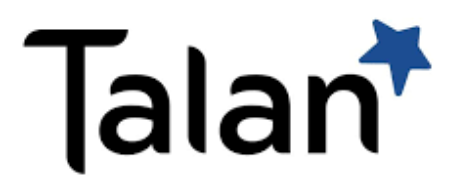
In this article, Samuel BRAL (ESSEC Business School, Global Bachelor in Business Administration (GBBA), 2022-2026) shares his professional experience as Assistant Financial Controller at Talan.
About the company
Talan is a French consulting and IT services firm that supports large organizations in their digital transformation. Founded in 2002, the group now operates in over 15 countries with more than 5,000 employees. Its activities cover business consulting, data & AI, transformation management, and IT systems integration.
The company has experienced rapid growth in recent years, reaching €600 million in revenue in 2023. Talan’s value proposition lies in combining business understanding with technical expertise to create tailored, high-impact solutions.
Logo of Talan.

Source: the company.
I worked within the Group FP&A (Financial Planning & Analysis) department at the Paris headquarters. This central team oversees the performance monitoring and financial reporting for all business units (BU), directly supporting the CFO and COMEX.
My internship
My missions
During my internship at Talan, my missions focused on supporting financial reporting, tool optimization, and performance monitoring across Talan’s international business units. My first responsibility was to assist in producing monthly management reports and P&L statements for each business unit. To do so, I extracted and reconciled financial data from systems such as Kimble, Jedox, and SuccessFactors. I created detailed revenue and margin reports used by the CFO and COMEX during monthly performance reviews. In one instance, I was tasked with explaining a sudden drop in margin for the Iberia BU, which led me to identify under-reported subcontractor costs and propose adjustments that improved margin accuracy by 15%.
In parallel, I was assigned to enhance and maintain our internal reporting tools. I updated Power BI dashboards to reflect changes in budget KPIs, created dynamic filters to allow managers to track performance by project or team, and integrated new reporting metrics requested by HR. A concrete example includes building a resource utilization dashboard that tracked billable vs. non-billable hours across 20+ consultants. This became a key element in weekly performance meetings.
I also contributed to the improvement of the Jedox budgeting model by testing input logic and spotting misalignments between operational forecasts and financial planning. My test case simulation revealed a recurring mismatch between headcount forecasts in SuccessFactors and budgeted salaries in Jedox, this insight helped improve the accuracy of HR cost planning. Lastly, I supported daily project performance follow-up. I maintained Excel trackers for monitoring project delivery rates, billing status, and work-in-progress (WIP). In one project, I flagged €1.2 million in delayed invoices at our UK subsidiary and proposed a process with the project manager and billing team to correct invoice triggers and reduce WIP exposure the following month.
Required skills and knowledge
This internship demanded both technical and soft skills. Technically, I had to master Excel (pivot tables, advanced formulas), Power BI, and become comfortable with integrated tools like Jedox, Kimble, and SuccessFactors. A solid understanding of accounting principles and management control basics was essential to analyze P&Ls and challenge budget assumptions.
But beyond tools and numbers, what really made a difference was my ability to adapt quickly, communicate clearly, and collaborate with different teams: from business unit managers to the finance department. I learned how to handle pressure during closing periods and gained confidence in presenting insights to senior stakeholders.
What I learned
This experience allowed me to apply classroom knowledge to real-world challenges. I saw how data, when properly structured and analyzed, can support strategic decision-making. I also learned the importance of data reliability, reconciling figures between systems and ensuring consistency across dashboards was a daily concern. Finally, I came out of the internship with a clearer picture of what FP&A means in practice: it’s not just about reporting, but about driving performance.
Financial concepts related to my internship
I present below three financial concepts related to my internship: variance analysis, working capital, and margin optimization.
Variance Analysis
Variance analysis was at the heart of my role. Each month, we compared actual figures with the budget and previous year (N-1) to explain key deviations in revenue, costs, and margins. This involved discussions with business unit heads to understand operational reasons behind the numbers: new project delays, staffing issues, or cost overruns. It’s a fundamental tool for financial control and performance steering.
Working Capital
Although I didn’t manage working capital directly, I learned how crucial it is in project-based firms like Talan. Delays in project billing or collection can quickly impact cash flow. Some of our dashboards tracked project completion status vs. invoicing, helping identify WIP (Work in Progress) accumulation. It gave me a concrete view of how accounting flows translate into liquidity risks.
Margin Optimization
One of our KPIs was project margin, calculated using resource allocation, billing rates (TJM), and direct costs. I worked on visualizing these margins in Power BI and exploring scenarios with the team. For example, we modelled the impact of raising the average billing rate or optimizing staffing on low-yield projects. This showed me how financial insight directly supports business decisions.
Why should I be interested in this post?
If you’re an ESSEC student interested in corporate finance, FP&A is a great field to explore. This internship gave me exposure to reporting, performance analysis, budgeting, and tools like Power BI and Jedox. It’s also a great entry point to understand how strategy and operations connect through numbers.
Related posts on the SimTrade blog
▶ All posts about Professional experiences
Useful resources
About the author
The article was written in September 2025 by Samuel BRAL (ESSEC Business School, Global Bachelor in Business Administration, 2022–2026).
